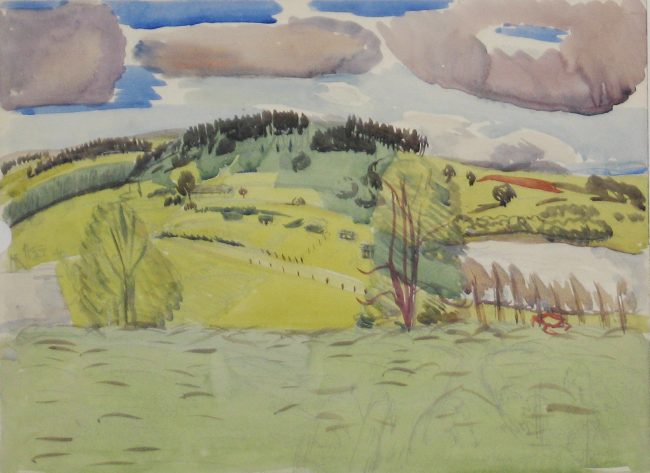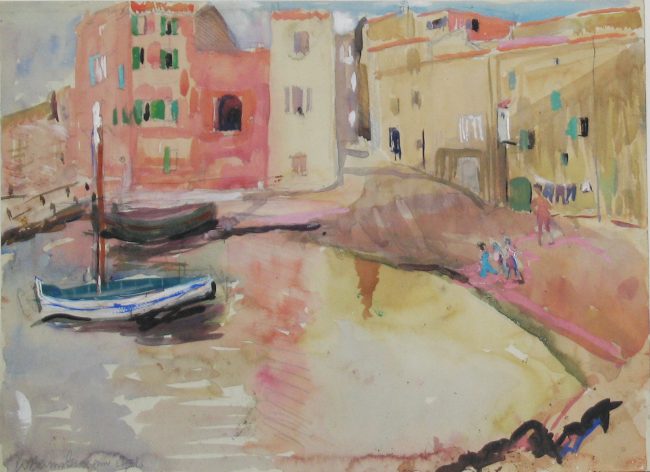The Early Watercolours

Carbeth, c. 1932, Pencil and watercolour on paper, BGT2700
THIS ARTICLE ACCOMPANIES THE ON-LINE DISPLAY – THE EARLY WATERCOLOURS
For many people, Wilhelmina Barns-Graham is a distinctly St Ives artist, one of the members of the St Ives group that made major contributions to Modern British art in the second half of the twentieth century. St Ives was the essential catalyst to the furtherment of her career, as was her early friendship with the artists Ben Nicholson and Naum Gabo while they lived there. 1940s St Ives was a hub for the exchange of ideas on modernism, Gabo’s contribution being of particular significance for her.
Barns-Graham arrived in St Ives in March 1940 after graduating with her diploma from Edinburgh College of Art (ECA) in 1937. At the age of twenty-eight, she arrived as a mature, fully trained artist. Her Scottish background was the subject of the centenary exhibition Wilhelmina Barns-Graham: A Scottish artist in St Ives in 2012, seen that year at the Fleming Collection Gallery in London and Edinburgh City Art Centre. (It was subsequently held at Penlee House Museum, Penzance in 2016.) The exhibition examined her art college training, who her teachers were, and how her early work developed, outlining the characteristics of her artistic Scottish heritage which she took with her to St Ives. One aspect of her student and early career art not represented in that exhibition was her watercolours, a collection of which are held by the Wilhelmina Barns-Graham Trust.
It is known that Barns-Graham enjoyed making art at an early age. The most accomplished from her teenage years are watercolours done during her time at St Hilda’s, a girl’s school in Liberton, Edinburgh which she attended between 1927 and 1930. The example here shows a confident handling of the medium while also revealing an individual eye for composition.
At that time, the family were living at Carbeth House, Blanefield, Stirlingshire, having moved there from St Andrews in 1924. The four watercolours of Carbeth were made between 1930 and 1932. The landscape in the area around the estate is mainly agricultural, with views to distant mountains that mark the beginning of the Highlands. The family home was quite isolated, Barns-Graham left to her own devices and to explore. Her interest in nature stemmed from then. The watercolours are simply done, her compositions intelligently constructed, the vantage points lifted high in the foreground, the angles and shapes creatively aligned. The freely applied brush marks give form to the haystacks and trees, animating the scene, displaying an intuitive grasp of the medium.
The art college years provided a more rigorous training than she had experienced previously. Her primary painting teachers were William Gillies and Adam Bruce Thomson, the former having a particularly influential impact on her which lasted for decades. One can see Gillies’s methods in her drawing throughout her career. He favoured an expressive approach to painting, a manner which he had picked up from the work of Christopher Wood, and Ben and Winifred Nicholson in the 1920s, particularly from their work in landscape.
Nonetheless, Barns-Graham was obliged to work on the college curriculum, represented here by this group of watercolour still-lives. Although they are academic in their execution, she manages to imbue considerable life into the objects, the form and texture of the fruit and tableware convincingly handled. The colour is rich and typical of what we consider as being of key importance in Scottish Art, inspired further, perhaps, by her viewing of the Edvard Munch and Paul Klee exhibitions held in Edinburgh in 1931 and 1934.
Most of Barns-Graham’s post college watercolours reflect her travels. It appears she travelled with pad, pencil and travelling watercolour cases to hand wherever she went. There were journeys to London between 1934 and 1936, and a holiday spent with friends on Iona in 1935. In 1936 she journeyed to St Tropez with her art college friend Margaret Mellis. The watercolours from that visit are full of bright colour and Mediterranean light, quickly painted into her sketchbook. One sees a loosening up of her brushwork arising from not just the speed with which she was working but her experimentation with a freer painting style.
The last group of watercolours came from time spent travelling around Scotland in the summer of 1939 – to Aviemore, Rothiemurchus Forest and Kirkcudbright. She had received a travel scholarship but this came with the condition that she study landscape and landscape artists. Having been to Henley on Thames and London beforehand, Barns-Graham headed to the Highlands. The resulting watercolours show further experimentation and continued improvement in her handling of the medium. They capture superbly the character of landscape, its colours and moods – note the two different versions of the same scene. These were her last landscapes before her life-changing move to St Ives in the following March, where the colours and shapes of that landscape was to exert such considerable impact on the development of her art.
Geoffrey Bertram
August 2020

St Tropez, 1936, watercolour on paper, 25.5 x 35.5 cm, BGT1418
![[Untitled - Highlands, Scotland] 1939 watercolour on paper 29 x 39.5 cm BGT2705](https://www.barns-grahamtrust.org.uk/wp-content/uploads/2020/08/1939205BScotland5D20BGT2705-650x467.jpg)
[Untitled - Highlands, Scotland] 1939 watercolour on paper 29 x 39.5 cm BGT2705
